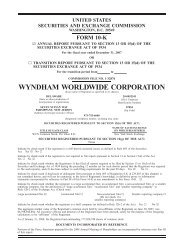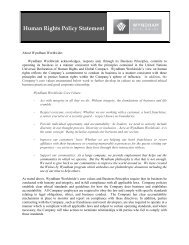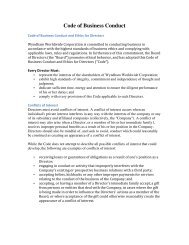WYNDHAM WORLDWIDE CORPORATION
WYNDHAM WORLDWIDE CORPORATION
WYNDHAM WORLDWIDE CORPORATION
Create successful ePaper yourself
Turn your PDF publications into a flip-book with our unique Google optimized e-Paper software.
Goodwill<br />
In accordance with the guidance for goodwill and other intangible assets, the Company tests goodwill for<br />
potential impairment annually (during the fourth quarter of each year subsequent to completing the Company’s<br />
annual forecasting process) and between annual tests if an event occurs or circumstances change that would more<br />
likely than not reduce the fair value of a reporting unit below its carrying amount.<br />
The process of evaluating goodwill for impairment involves the determination of the fair value of the Company’s<br />
reporting units as described in Note 2 — Summary of Significant Accounting Policies. Because quoted market prices for<br />
the Company’s reporting units are not available, management must apply judgment in determining the estimated fair<br />
value of these reporting units for purposes of performing the annual goodwill impairment test. Management uses all<br />
available information to make these fair value determinations, including the present values of expected future cash flows<br />
using discount rates commensurate with the risks involved in the assets. Inherent in such fair value determinations are<br />
certain judgments and estimates relating to future cash flows, including the Company’s interpretation of current economic<br />
indicators and market valuations, and assumptions about the Company’s strategic plans with regard to its operations. Due<br />
to the uncertainties associated with such estimates, actual results could differ from such estimates. In performing its<br />
impairment analysis, the Company developed the estimated fair values for its reporting units using a combination of the<br />
discounted cash flow methodology and the market multiple methodology.<br />
The discounted cash flow methodology establishes fair value by estimating the present value of the projected<br />
future cash flows to be generated from the reporting unit. The discount rate applied to the projected future cash<br />
flows to arrive at the present value is intended to reflect all risks of ownership and the associated risks of realizing<br />
the stream of projected future cash flows. The discounted cash flow methodology uses the Company’s projections of<br />
financial performance for a five-year period. The most significant assumptions used in the discounted cash flow<br />
methodology are the discount rate, the terminal value and expected future revenues, gross margins and operating<br />
margins, which vary among reporting units.<br />
The Company uses a market multiple methodology to estimate the terminal value of each reporting unit by<br />
comparing such reporting unit to other publicly traded companies that are similar to it from an operational and<br />
economic standpoint. The market multiple methodology compares each reporting unit to the comparable companies<br />
on the basis of risk characteristics in order to determine the risk profile relative to the comparable companies as a<br />
group. This analysis generally focuses on quantitative considerations, which include financial performance and other<br />
quantifiable data, and qualitative considerations, which include any factors which are expected to impact future<br />
financial performance. The most significant assumption affecting the Company’s estimate of the terminal value of<br />
each reporting unit is the multiple of the enterprise value to earnings before interest, tax, depreciation and<br />
amortization.<br />
To support the Company’s estimate of the individual reporting unit fair values, a comparison is performed<br />
between the sum of the fair values of the reporting units and the Company’s market capitalization. The Company<br />
uses an average of its market capitalization over a reasonable period preceding the impairment testing date as being<br />
more reflective of the Company’s stock price trend than a single day, point-in-time market price. The difference is<br />
an implied control premium, which represents the acknowledgment that the observed market prices of individual<br />
trades of a company’s stock may not be representative of the fair value of the company as a whole. Estimates of a<br />
company’s control premium are highly judgmental and depend on capital market and macro-economic conditions<br />
overall. The Company concluded that the implied control premium estimated from its analysis is reasonable.<br />
During the fourth quarters of 2010 and 2009, the Company performed its annual goodwill impairment test and<br />
determined that no impairment was required as the fair value of goodwill at its lodging and vacation exchange and<br />
rentals reporting units was substantially in excess of the carrying value.<br />
During the fourth quarter of 2008, after estimating the fair values of the Company’s three reporting units as of<br />
December 31, 2008, the Company determined that its lodging and vacation exchange and rentals reporting units<br />
passed the first step of the goodwill impairment test, while the vacation ownership reporting unit did not pass the<br />
first step.<br />
As described in Note 2 — Summary of Significant Accounting Policies, the second step of the goodwill<br />
impairment test uses the estimated fair value of the Company’s vacation ownership segment from the first step as<br />
the purchase price in a hypothetical acquisition of the reporting unit. The significant hypothetical purchase price<br />
allocation adjustments made to the assets and liabilities of the vacation ownership segment in this second step<br />
calculation were in the areas of:<br />
(1) Adjusting the carrying value of Vacation Ownership Contract Receivables to their estimated fair<br />
values,<br />
(2) Adjusting the carrying value of customer related intangible assets to their estimated fair values,<br />
F-17







